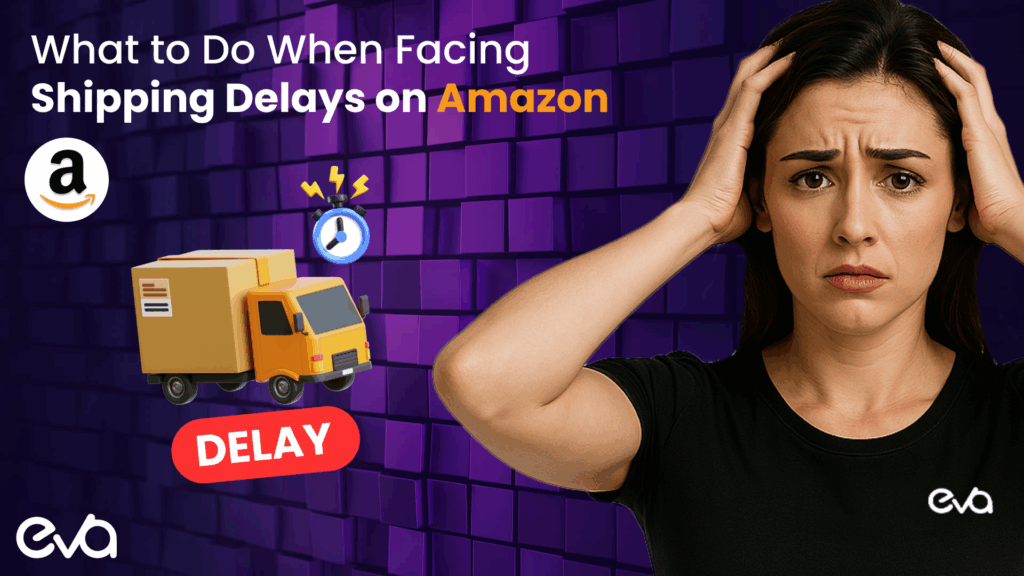In the fast-paced world of e-commerce, shipping delays can significantly impact both customer satisfaction and seller performance metrics. Even with Amazon’s sophisticated logistics network, delays happen due to various factors ranging from seasonal surges to unexpected global events.
Knowing how to effectively manage these situations can protect your business reputation and keep customers happy.
Let’s take a closer look at practical strategies for handling shipping delays on Amazon from both customer and seller perspectives.
Table of Contents
- Understanding What Causes Amazon Shipping Delays
- Effective Strategies for Customers Facing Delays
- Proactive Measures for Sellers to Prevent and Manage Delays
- Professional Communication Strategies During Shipping Delays
- Compensation and Resolution Options
- Prepare for Predictable Delay Periods
- Maximize Your Amazon Operations with Eva
Understanding What Causes Amazon Shipping Delays
Before addressing solutions, it’s important to recognize why shipping delays occur in the first place. This understanding helps set realistic expectations and informs your response strategy.
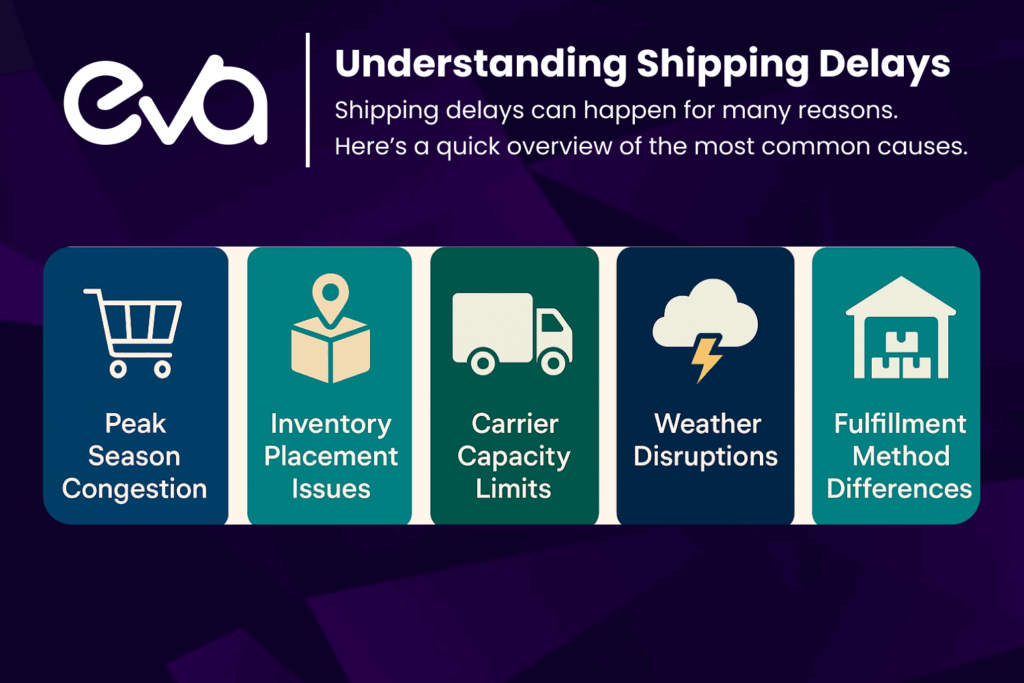
Peak Season Congestion
Holiday seasons and major shopping events like Prime Day create enormous pressure on Amazon’s fulfillment network. During the fourth quarter especially, order volumes can double or triple, leading to processing backlogs despite Amazon’s extensive preparation.
Inventory Placement Issues
Amazon’s fulfillment network spans hundreds of warehouses across the country. Sometimes products need to be transferred between facilities to reach customers, adding extra days to delivery timelines that aren’t immediately apparent to buyers.
Carrier Capacity Limitations
Even when Amazon processes orders promptly, external shipping carriers like UPS, FedEx, and USPS may face capacity constraints. This became particularly evident during the pandemic but continues to impact delivery reliability during high-volume periods.
Weather Disruptions and Force Majeure Events
Severe weather, natural disasters, and unforeseen circumstances create unpredictable disruptions that can affect entire regions. These events often cause the most frustrating delays because they’re beyond anyone’s control.
Fulfillment Method Differences
Products shipped directly from third-party sellers typically have longer delivery windows than those fulfilled by Amazon. Customers often miss this distinction when placing orders, leading to misaligned expectations.
Effective Strategies for Customers Facing Delays
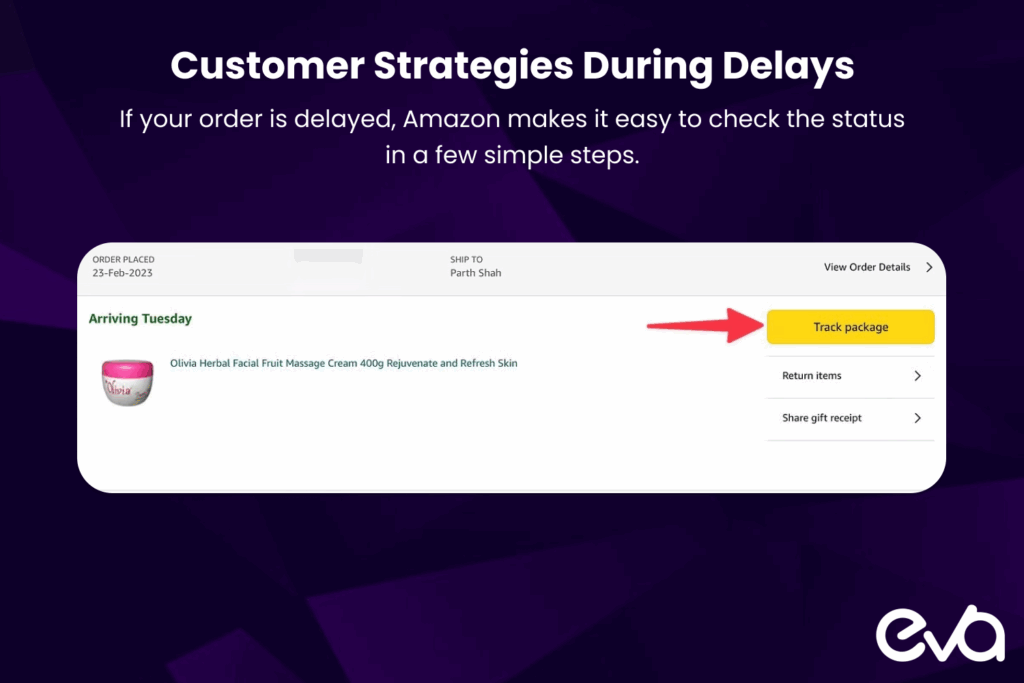
When your Amazon package isn’t arriving on schedule, these practical steps can help resolve the situation:
Verify Order Status Through Official Channels
Always start by checking your order status directly through Amazon’s website or app. This provides the most current information and often includes updated delivery estimates when delays occur.
Navigate to Your Orders > Order Details to find:
- Current shipment status
- Tracking information
- Updated delivery estimates
- Potential delivery issues
Understand Amazon’s Shipping Guarantee
Amazon’s delivery guarantees vary by product and shipping method:
- Prime products with specified delivery dates are backed by Amazon’s delivery guarantee
- Items with “guaranteed delivery dates” qualify for compensation if delivery promises aren’t met
- Products shipped by third-party sellers often have different policies
Contact Customer Service Strategically
If your package is significantly delayed beyond the estimated delivery date:
- Use the “Contact Us” option in the Orders section
- Select your specific order and choose “Where’s my stuff?” as the issue
- Be prepared with order details and the nature of your concern
- Request specific solutions like expedited replacement shipping or partial refunds for Prime members
Amazon’s customer service representatives have considerable flexibility to resolve shipping issues, especially for Prime members or when Amazon has explicitly guaranteed a delivery date.
Consider Alternative Fulfillment Options
If you need an item urgently and your current order is delayed:
- Check if the same product is available with faster shipping from another seller
- Look for “Available at a store near you” options that Amazon now offers with certain retail partners
- Consider Amazon Same-Day Delivery where available for critical purchases
Proactive Measures for Sellers to Prevent and Manage Delays
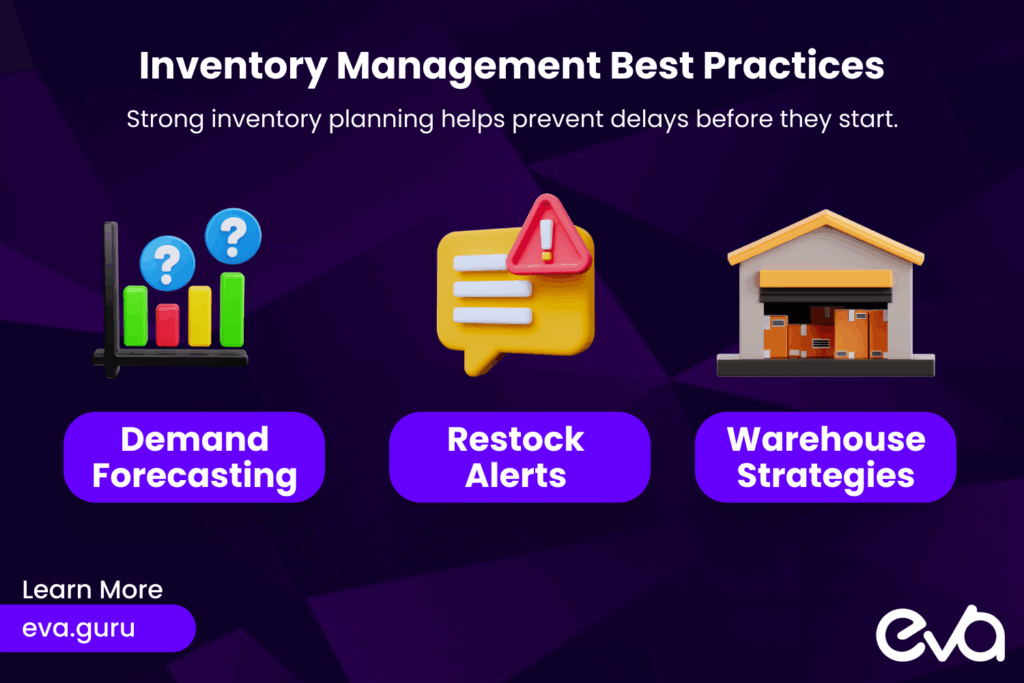
For sellers, Amazon shipping delays can damage your account health metrics and customer relationships. Here’s how to minimize their impact:
Implement Strategic Inventory Management
The most effective way to prevent shipping delays is maintaining optimal inventory levels:
- Use historical data and forecasting tools to anticipate demand fluctuations
- Set automated restock alerts before inventory reaches critical levels
- Buffer your stock during Q4 and other high-demand periods
- Consider splitting inventory across multiple fulfillment centers for faster nationwide delivery
Optimize Your Fulfillment Strategy
Choose the right fulfillment method for your business model:
- FBA (Fulfillment by Amazon): Provides the most reliable shipping speeds and customer service, but requires careful inventory planning
- FBM (Fulfilled by Merchant): Gives you complete control over shipping but places full responsibility for delays on your business
- SFP (Seller Fulfilled Prime): Offers a middle ground but requires meeting strict shipping standards
Many successful sellers use a hybrid approach, leveraging FBA for fast-moving products while fulfilling specialized or oversized items themselves.
Master Amazon’s Shipping Tools
For seller-fulfilled orders, Amazon provides robust shipping tools that can streamline your process:
- Use Amazon Buy Shipping for discounted rates and automatic tracking uploads
- Set realistic handling times that you can consistently meet
- Consider upgrading shipping methods during peak seasons to maintain performance metrics
- Regularly review late shipment reports to identify and address recurring issues
Professional Communication Strategies During Shipping Delays
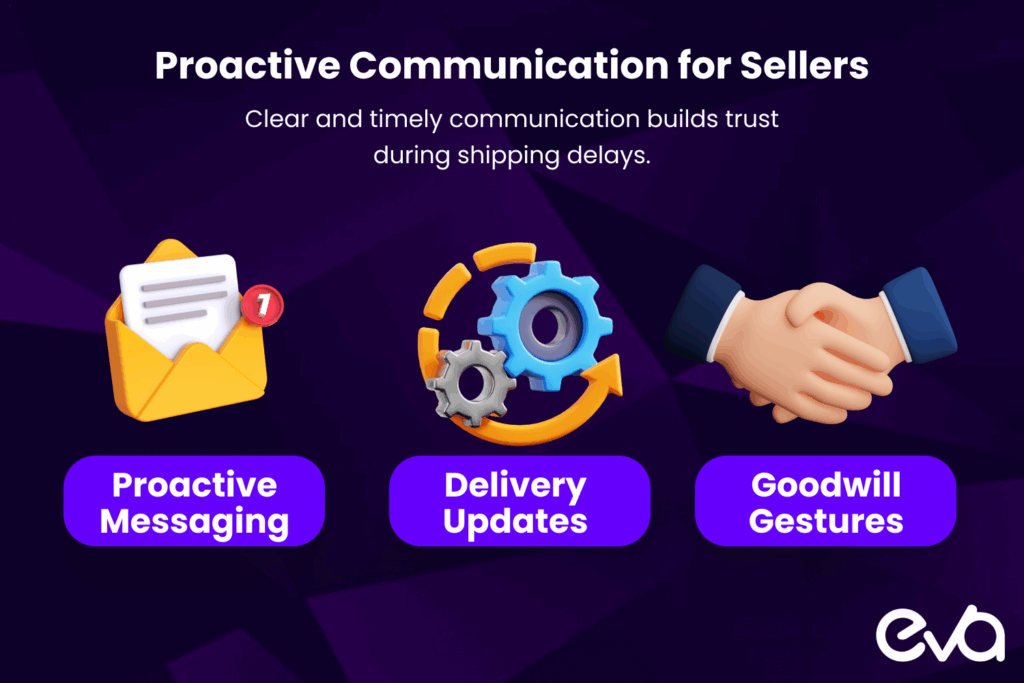
How you communicate during delays often matters more than the delay itself. These approaches help maintain customer confidence:
For Sellers: Proactive Transparency
When delays are inevitable, communicate early and honestly:
- Send proactive messages through Buyer-Seller Messaging as soon as you anticipate a delay
- Clearly explain the cause while taking appropriate responsibility
- Provide revised delivery estimates based on realistic assessments
- Offer compensation options when appropriate (partial refunds, discounts on future orders)
Customers appreciate honesty and are generally understanding when kept informed, even if the news isn’t what they hoped to hear.
For Customers: Productive Engagement
When contacting Amazon or sellers about delays:
- Provide specific order information (order number, expected delivery date)
- Clearly state how the delay impacts you
- Request specific, reasonable solutions
- Remain courteous even when frustrated (this typically leads to better outcomes)
Compensation and Resolution Options
What Customers Can Expect
When delays occur with guaranteed deliveries, Amazon typically offers:
- One-month extension of Prime membership for Prime customers
- Refund of shipping fees for non-Prime orders
- $5-$10 promotional credit in some cases
- Full refunds for extremely delayed items without requiring returns
What Sellers Should Consider Offering
For seller-fulfilled orders with unavoidable delays:
- Partial refunds to compensate for inconvenience
- Expedited shipping on replacement items
- Discount codes for future purchases
- Complimentary add-on products with delayed orders
These goodwill gestures often cost less than the negative impact of poor reviews and can convert frustrated customers into loyal ones.
Prepare for Predictable Delay Periods
Some shipping delays are more predictable than others, allowing for advance planning:
High-Risk Periods for Delays
- Black Friday through Christmas (late November to late December)
- Prime Day and other major Amazon sale events
- Severe weather seasons in affected regions
- First week of each month (higher order volumes due to paycheck cycles)
Both customers and sellers should adjust expectations and strategies during these periods.
Maximize Your Amazon Operations with Eva
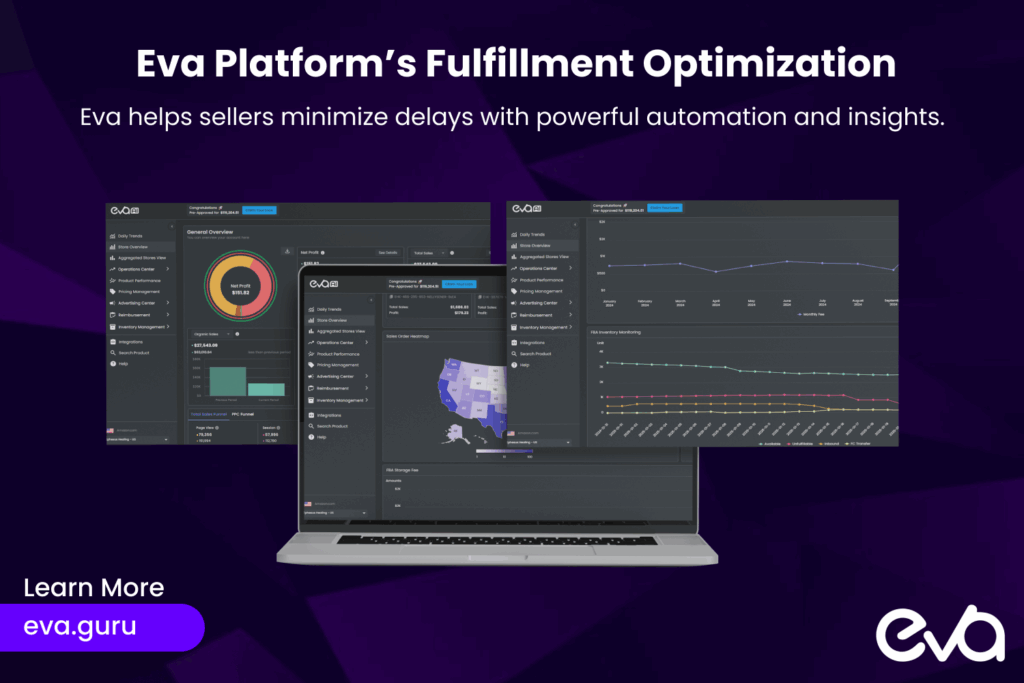
While shipping delays are sometimes unavoidable, having the right systems in place can dramatically reduce their frequency and impact on your business. Eva’s comprehensive platform helps Amazon sellers optimize their entire fulfillment process to prevent delays before they happen.
How Eva Transforms Your Amazon Fulfillment Strategy:
Inventory Intelligence: Our AI-powered inventory forecasting prevents stockouts while avoiding excessive storage fees. By analyzing historical sales patterns, seasonal trends, and marketplace dynamics, we help you maintain optimal inventory levels at all times.
Performance Monitoring: Eva automatically tracks your account health metrics, alerting you to potential shipping-related issues before they affect your seller standing. Our dashboard highlights late shipments, tracking issues, and other factors that could impact your fulfillment performance.
Multi-Channel Synchronization: For sellers operating across multiple platforms, our system ensures inventory stays synchronized, preventing overselling situations that lead to fulfillment delays.
Automated Alerts: Receive instant notifications when weather events, carrier issues, or Amazon policy changes might affect your shipments, allowing you to proactively communicate with customers.
Fulfillment Optimization: Our platform analyzes your fulfillment costs and performance to recommend the optimal mix of FBA, FBM, and SFP for your unique product catalog.
Eva clients typically experience a significant reduction in shipping-related problems after implementing our platform, leading to higher customer satisfaction rates and improved account health metrics. By preventing avoidable delays and managing unavoidable ones more effectively, our sellers maintain better performance rankings even during the most challenging seasons.
Ready to transform your Amazon fulfillment strategy and minimize shipping delays? Try Eva’s platform free for 14 days and discover how data-driven fulfillment management can protect your reputation and grow your business.

